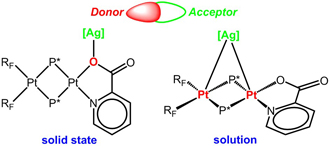|
The reactions of [Ag(OClO3)(PPh3)] with [NBu4][(C6F5)2Pt(μ-PPh2)2M(hq)], [NBu4][(C6F5)2Pt(μ-PPh2)2M(bq)], [NBu4][(C6F5)2Pt(μ-PPh2)2M(pic)] and [NBu4][(C6F5)2Pt(μ-PPh2)2Pt(C6F5)(tht)] (M = Pt, Pd; hq = 8-hydroxyquinolinate, bq = benzoquinolinate, pic = picolinate, tht = tetrahydrothiophene) afford the corresponding neutral adducts [(C6F5)2Pt(μ-PPh2)2(μ-AgPPh3)M(bq)] (M = Pt, 1; Pd, 2), [(C6F5)2Pt(μ-PPh2)2(μ-AgPPh3)M(hq)] (M = Pt, 3; Pd, 4) [(C6F5)2Pt(μ-PPh2)2(μ-AgPPh3)Pt(C6F5)(tht)] (5) and [(C6F5)2Pt(μ-PPh2)2M(pic-AgPPh3)] (M = Pt, 6; Pd, 7) as yellow solids. The XRD structures of 1–5, in which a [AgPPh3]+ moiety bridges the metal centres, were confirmed in solution at low temperature. At room temperature, a dynamic process for the [AgPPh3]+ moiety, which passes from the top to the bottom part of the molecules 1–5, was ascertained. For 6 and 7, the XRD analyses revealed structures in which the [AgPPh3]+ moiety is linked to the picolinate oxygen atom bonded to the M centre; however, although such a structure was confirmed in solution for the Pt–Pd species 7, the stable form of the Pt–Pt species 6 in solution is that with the [AgPPh3]+ moiety bridging the metal centres.
|

